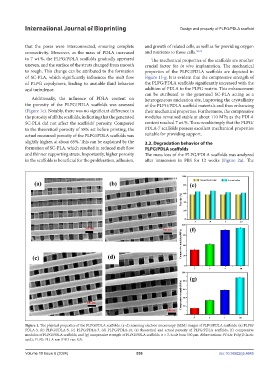Page 544 - IJB-10-6
P. 544
International Journal of Bioprinting Design and property of PLPG/PDLA scaffold
that the pores were interconnected, ensuring complete and growth of related cells, as well as for providing oxygen
connectivity. Moreover, as the mass of PDLA increased and nutrients to those cells. 30,31
to 7 wt.%, the PLPG/PDLA scaffolds gradually appeared The mechanical properties of the scaffolds are another
uneven, and the surface of the struts changed from smooth crucial factor for in vivo implantation. The mechanical
to rough. This change can be attributed to the formation properties of the PLPG/PDLA scaffolds are depicted in
of SC-PLA, which significantly influences the melt flow Figure 1f–g. It is evident that the compressive strength of
of PLPG copolymers, leading to unstable fluid behavior the PLPG/PDLA scaffolds significantly increased with the
and turbulence. addition of PDLA to the PLPG matrix. This enhancement
can be attributed to the generated SC-PLA acting as a
Additionally, the influence of PDLA content on heterogeneous nucleation site, improving the crystallinity
the porosity of the PLPG/PDLA scaffolds was assessed of the PLPG/PDLA scaffold materials and thus enhancing
(Figure 1e). Notably, there was no significant difference in their mechanical properties. Furthermore, the compressive
the porosity of all the scaffolds, indicating that the generated modulus remained stable at about 110 MPa as the PDLA
SC-PLA did not affect the scaffolds’ porosity. Compared content reached 7 wt.%. These results imply that the PLPG/
to the theoretical porosity of 58% set before printing, the PDLA-7 scaffolds possess excellent mechanical properties
actual measured porosity of the PLPG/PDLA scaffolds was suitable for providing support.
slightly higher, at about 65%. This can be explained by the 3.2. Degradation behavior of the
formation of SC-PLA, which resulted in reduced melt flow PLPG/PDLA scaffolds
and thinner supporting struts. Importantly, higher porosity The mass loss of the PLPG/PDLA scaffolds was analyzed
in the scaffolds is beneficial for the proliferation, adhesion, after immersion in PBS for 12 weeks (Figure 2a). The
Figure 1. The physical properties of the PLPG/PDLA scaffolds. (a–d) scanning electron microscopy (SEM) images of PLPG/PDLA scaffolds: (a) PLPG/
PDLA-3, (b) PLPG/PDLA-5, (c) PLPG/PDLA-7, (d) PLPG/PDLA-10, (e) theoretical and actual porosity of PLPG/PDLA scaffolds, (f) compressive
modulus of PLPG/PDLA scaffolds, and (g) compressive strength of PLPG/PDLA scaffolds. n = 3. Scale bars: 500 µm. Abbreviations: PDLA: Poly(D-lactic
acid); PLPG: PLLA-ran-PDO-ran-GA.
Volume 10 Issue 6 (2024) 536 doi: 10.36922/ijb.4645

